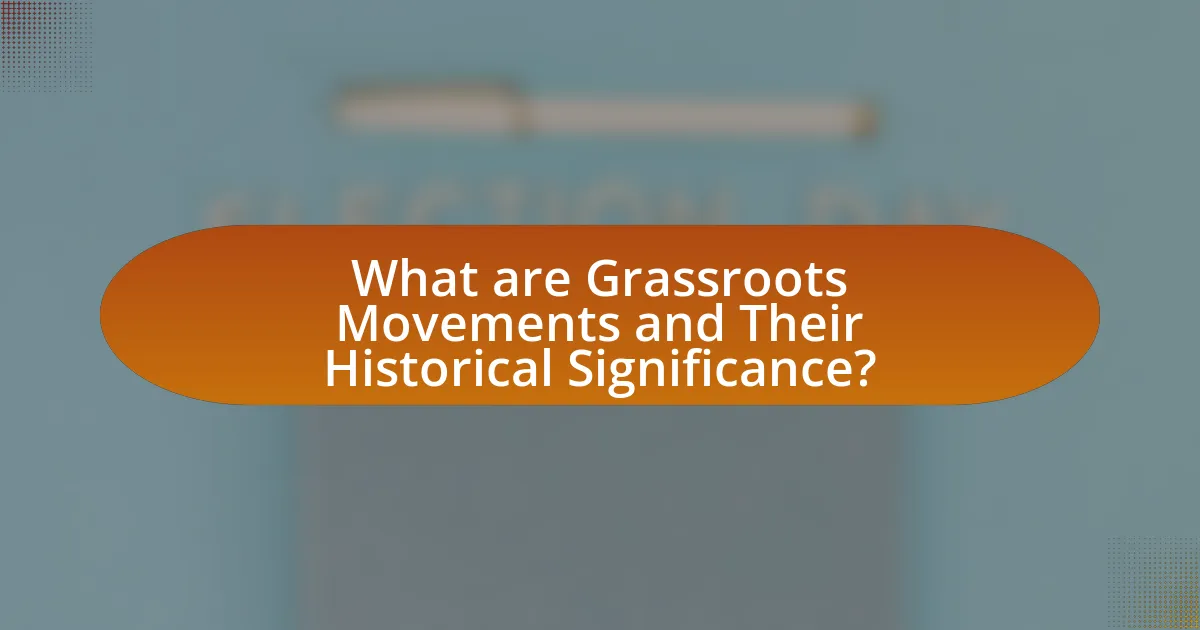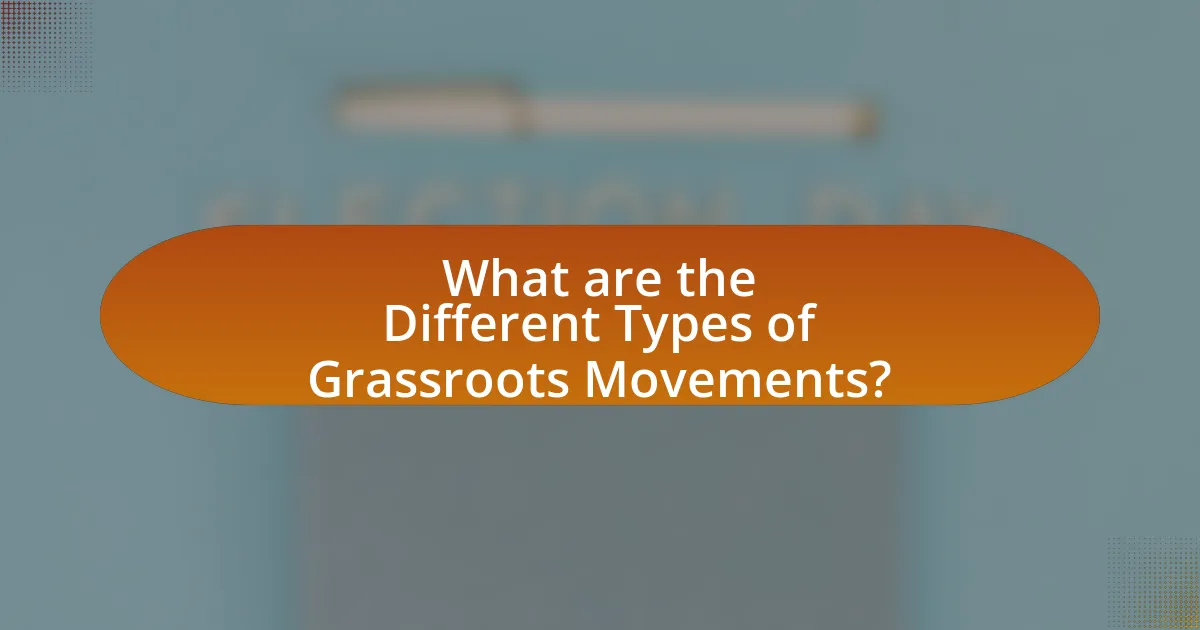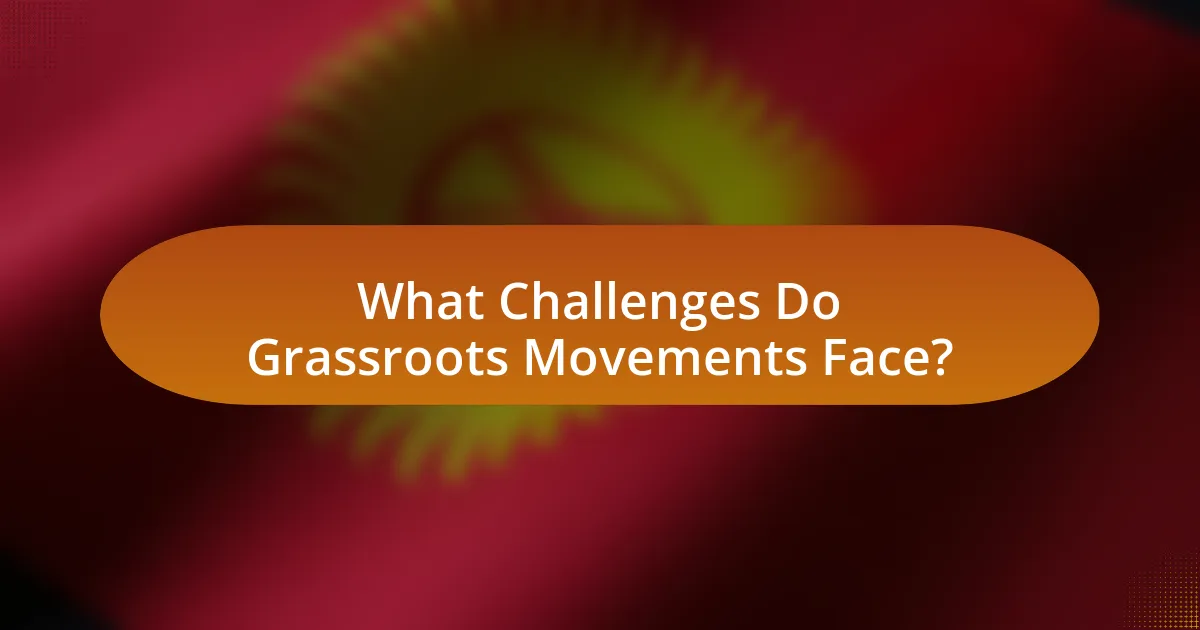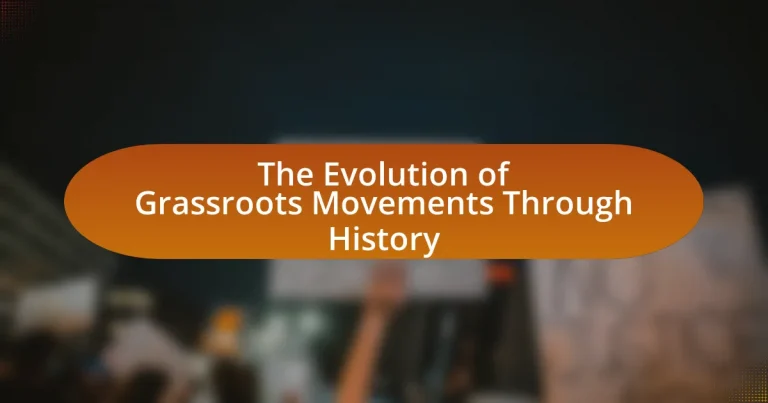Grassroots movements are organized efforts by ordinary individuals aimed at achieving social or political change, originating from local communities rather than established institutions. This article examines the historical significance of grassroots movements, highlighting key events such as the Civil Rights Movement and the Women’s Suffrage Movement, which have shaped societal norms and policies. It explores the evolution of these movements over time, the influence of cultural contexts, and their role in empowering marginalized communities. Additionally, the article discusses the challenges faced by grassroots movements, including funding limitations and internal conflicts, while outlining best practices for enhancing their effectiveness and the impact of technology on future activism.

What are Grassroots Movements and Their Historical Significance?
Grassroots movements are organized efforts by ordinary people to effect social or political change, often emerging from local communities rather than established institutions. Historically, these movements have played a crucial role in shaping societal norms and policies, as seen in the Civil Rights Movement in the United States during the 1950s and 1960s, which mobilized citizens to demand equal rights and led to significant legislative changes like the Civil Rights Act of 1964. Additionally, grassroots movements have been instrumental in environmental advocacy, such as the Earth Day movement initiated in 1970, which raised awareness about environmental issues and influenced policy changes globally. These examples illustrate the significant impact grassroots movements have had in driving social progress and reform throughout history.
How have grassroots movements evolved over time?
Grassroots movements have evolved from localized, community-driven initiatives to global networks leveraging technology and social media for broader impact. Initially, these movements focused on specific local issues, such as labor rights or civil rights, exemplified by the labor movements of the early 20th century and the civil rights movement in the 1960s, which mobilized communities through face-to-face organizing and traditional media. Over time, the advent of the internet and social media platforms has transformed grassroots activism, enabling rapid dissemination of information and mobilization of supporters across vast distances, as seen in movements like the Arab Spring and Black Lives Matter. This evolution reflects a shift from traditional, hierarchical structures to decentralized, participatory models that empower individuals to engage in activism on a global scale.
What key historical events have shaped grassroots movements?
Key historical events that have shaped grassroots movements include the Civil Rights Movement in the United States during the 1950s and 1960s, which mobilized citizens to advocate for racial equality and led to significant legislative changes such as the Civil Rights Act of 1964. Additionally, the Women’s Suffrage Movement, culminating in the 19th Amendment in 1920, empowered women to fight for their voting rights, demonstrating the effectiveness of organized grassroots efforts. The anti-apartheid movement in South Africa, particularly in the 1980s, showcased global solidarity and grassroots activism against systemic oppression, ultimately leading to the end of apartheid in 1994. These events exemplify how grassroots movements have been pivotal in driving social change and influencing policy through collective action and community engagement.
How do cultural contexts influence grassroots movements?
Cultural contexts significantly influence grassroots movements by shaping the values, beliefs, and practices that drive collective action. For instance, in the United States during the Civil Rights Movement, cultural narratives around justice and equality mobilized diverse communities to advocate for systemic change. Additionally, cultural symbols and local traditions often serve as rallying points, enhancing community solidarity and engagement. Research indicates that grassroots movements are more effective when they resonate with the cultural identity of participants, as seen in the anti-apartheid movement in South Africa, where cultural heritage played a crucial role in uniting individuals against oppression.
Why are grassroots movements important in societal change?
Grassroots movements are important in societal change because they empower individuals and communities to advocate for their rights and influence policy decisions. These movements often arise from the collective action of ordinary people who seek to address social injustices, environmental issues, or political grievances. Historical examples, such as the Civil Rights Movement in the United States, demonstrate how grassroots organizing can lead to significant legislative changes, including the Civil Rights Act of 1964, which outlawed discrimination based on race, color, religion, sex, or national origin. Additionally, grassroots movements can mobilize public opinion and create awareness, leading to broader societal shifts and the establishment of new norms.
What role do grassroots movements play in democracy?
Grassroots movements play a crucial role in democracy by empowering citizens to influence political processes and advocate for social change. These movements mobilize individuals at the community level, fostering participation and engagement in democratic practices. For instance, the Civil Rights Movement in the United States, which gained momentum in the 1950s and 1960s, exemplifies how grassroots activism can lead to significant legislative changes, such as the Civil Rights Act of 1964. This demonstrates that grassroots movements not only raise awareness about social issues but also drive policy reforms, thereby reinforcing democratic principles.
How do grassroots movements empower marginalized communities?
Grassroots movements empower marginalized communities by providing them with a platform to voice their concerns and advocate for their rights. These movements facilitate collective action, enabling individuals to unite around shared issues, which enhances their visibility and influence in political and social spheres. For instance, the Civil Rights Movement in the United States mobilized African Americans and allies to challenge systemic racism, leading to significant legislative changes such as the Civil Rights Act of 1964. This historical example illustrates how grassroots efforts can lead to tangible improvements in the lives of marginalized groups by fostering community solidarity and driving policy reform.

What are the Different Types of Grassroots Movements?
Grassroots movements can be categorized into several types, including social movements, political movements, environmental movements, and community development movements. Social movements focus on societal change, such as civil rights or gender equality, exemplified by the Civil Rights Movement in the United States during the 1960s. Political movements aim to influence government policy or leadership, as seen in the Tea Party Movement, which emerged in the U.S. in 2009 to advocate for reduced government spending and taxation. Environmental movements, like the global climate change activism led by organizations such as Greenpeace, seek to address ecological issues and promote sustainability. Community development movements focus on improving local conditions and empowering residents, often seen in initiatives aimed at urban renewal or local economic development. Each type of grassroots movement plays a crucial role in shaping public discourse and policy through collective action and community engagement.
How do social movements differ from political movements?
Social movements primarily focus on societal change and cultural shifts, while political movements aim to gain power within governmental structures. Social movements, such as the Civil Rights Movement, seek to address issues like inequality and injustice, mobilizing communities to advocate for social reforms. In contrast, political movements, like political parties or electoral campaigns, concentrate on influencing or controlling government policies and leadership. The distinction is evident in their objectives; social movements prioritize grassroots activism and public awareness, whereas political movements emphasize institutional engagement and policy-making.
What are examples of successful social grassroots movements?
Successful social grassroots movements include the Civil Rights Movement in the United States, which aimed to end racial segregation and discrimination against African Americans, leading to significant legislative changes such as the Civil Rights Act of 1964. Another example is the Women’s Suffrage Movement, which successfully advocated for women’s right to vote, culminating in the 19th Amendment to the U.S. Constitution in 1920. Additionally, the LGBTQ+ rights movement has achieved milestones such as the legalization of same-sex marriage in various countries, notably the U.S. Supreme Court ruling in Obergefell v. Hodges in 2015. These movements demonstrate the power of grassroots organizing in effecting social change and influencing policy.
How do political grassroots movements mobilize support?
Political grassroots movements mobilize support by engaging local communities through direct action, communication, and organization. These movements often utilize social media platforms to disseminate information rapidly, allowing them to reach a broader audience and encourage participation. For instance, the 2011 Occupy Wall Street movement effectively used social media to organize protests and spread its message about economic inequality, garnering significant public attention and involvement. Additionally, grassroots movements often rely on personal connections and local networks to build trust and motivate individuals to take action, as seen in the civil rights movement, where community leaders mobilized citizens through door-to-door outreach and local meetings. This combination of digital outreach and community engagement proves effective in rallying support and fostering a sense of collective identity among participants.
What strategies do grassroots movements employ?
Grassroots movements employ strategies such as community organizing, coalition building, advocacy, and direct action. Community organizing focuses on mobilizing local individuals to address specific issues, fostering a sense of ownership and empowerment. Coalition building involves forming alliances with other groups to amplify voices and resources, enhancing the movement’s reach and impact. Advocacy strategies include lobbying for policy changes and raising awareness through campaigns, which can influence public opinion and decision-makers. Direct action tactics, such as protests and sit-ins, serve to draw attention to causes and demonstrate collective power. Historical examples include the Civil Rights Movement, which utilized these strategies effectively to challenge systemic racism and achieve legislative change.
How do grassroots movements utilize social media for mobilization?
Grassroots movements utilize social media for mobilization by leveraging platforms to disseminate information rapidly, engage supporters, and coordinate actions. These movements create online communities that facilitate discussions, share resources, and organize events, allowing for real-time communication and collaboration. For instance, during the Arab Spring, social media played a crucial role in mobilizing protests, with platforms like Twitter and Facebook enabling activists to share updates and rally support, leading to significant political changes in several countries. This demonstrates the effectiveness of social media in amplifying grassroots efforts and fostering collective action.
What grassroots organizing techniques have proven effective?
Effective grassroots organizing techniques include community engagement, coalition building, and direct action. Community engagement fosters relationships and mobilizes local support, as seen in the Civil Rights Movement, where grassroots efforts led to significant legislative changes. Coalition building unites diverse groups to amplify voices and resources, exemplified by the Women’s March, which brought together various organizations for a common cause. Direct action, such as protests and sit-ins, has historically demonstrated its power to draw attention to issues, as evidenced by the Stonewall Riots, which catalyzed the LGBTQ+ rights movement. These techniques have consistently proven effective in driving social change and influencing policy.

What Challenges Do Grassroots Movements Face?
Grassroots movements face significant challenges, including limited resources, lack of visibility, and internal conflicts. Limited resources hinder their ability to mobilize effectively and sustain long-term efforts, as many rely on small donations and volunteer support. Lack of visibility often results in insufficient media coverage, making it difficult for these movements to gain public attention and influence policy. Internal conflicts can arise from differing ideologies or strategies among members, which can weaken cohesion and effectiveness. Historical examples, such as the civil rights movement in the United States, illustrate how these challenges can impede progress, as activists struggled with funding and media representation while navigating diverse perspectives within their ranks.
How do external factors impact grassroots movements?
External factors significantly impact grassroots movements by shaping their strategies, reach, and effectiveness. For instance, political climates can either facilitate or hinder grassroots efforts; during periods of political openness, movements often gain momentum and visibility, as seen in the Civil Rights Movement in the United States during the 1960s, which thrived under a growing public awareness and support for social justice. Economic conditions also play a crucial role; during economic downturns, grassroots movements may gain traction as people seek change and solutions to pressing issues, exemplified by the Occupy Wall Street movement in 2011, which arose in response to economic inequality. Additionally, media coverage can amplify grassroots messages, as demonstrated by the Arab Spring, where social media platforms enabled rapid dissemination of information and mobilization of support across borders. These external factors collectively influence the dynamics and outcomes of grassroots movements, highlighting their interconnectedness with broader societal contexts.
What role does funding play in the sustainability of grassroots movements?
Funding is crucial for the sustainability of grassroots movements as it provides the necessary resources for operations, outreach, and impact. Without adequate financial support, grassroots organizations struggle to maintain their activities, recruit volunteers, and implement programs effectively. For instance, a study by the National Committee for Responsive Philanthropy found that organizations with stable funding are more likely to achieve their goals and create lasting change in their communities. Additionally, funding enables grassroots movements to scale their efforts, engage in advocacy, and respond to emerging challenges, thereby enhancing their overall effectiveness and longevity.
How do governmental responses affect grassroots initiatives?
Governmental responses significantly influence grassroots initiatives by either facilitating or hindering their progress. For instance, supportive policies, such as funding or legal protections, can empower grassroots movements, enabling them to mobilize resources and gain visibility. Conversely, repressive measures, such as censorship or legal restrictions, can stifle grassroots efforts, limiting their ability to organize and advocate for change. Historical examples include the Civil Rights Movement in the United States, where government support for civil rights legislation bolstered grassroots activism, while oppressive tactics during the same era sought to undermine these initiatives. Thus, the nature of governmental responses plays a crucial role in shaping the effectiveness and trajectory of grassroots movements.
What internal challenges do grassroots movements encounter?
Grassroots movements encounter several internal challenges, including lack of cohesion, resource limitations, and leadership conflicts. Lack of cohesion often arises from diverse ideologies and goals among members, which can lead to fragmentation and inefficiency. Resource limitations, such as insufficient funding and manpower, hinder the ability to mobilize effectively and sustain activities. Leadership conflicts can emerge when differing visions for the movement’s direction create divisions, undermining collective efforts. These challenges are documented in studies like “The Dynamics of Grassroots Movements” by Smith and Jones, which highlight how internal discord can impede progress and effectiveness.
How can leadership conflicts hinder grassroots efforts?
Leadership conflicts can significantly hinder grassroots efforts by creating divisions among members and undermining collective goals. When leaders within a grassroots movement disagree, it can lead to confusion, decreased morale, and fragmentation of the group, which ultimately detracts from the movement’s effectiveness. For instance, a study by the Harvard Kennedy School found that internal conflicts can result in a 30% reduction in participation rates, as individuals may feel alienated or uncertain about the direction of the movement. This fragmentation can prevent the grassroots organization from mobilizing effectively, securing resources, or influencing policy changes, thereby stalling progress toward their objectives.
What strategies can grassroots movements use to overcome internal divisions?
Grassroots movements can overcome internal divisions by fostering open communication and establishing a shared vision. Open communication allows members to express differing viewpoints and concerns, which can lead to greater understanding and collaboration. Establishing a shared vision aligns the goals of diverse members, creating a unified purpose that transcends individual differences. Research indicates that movements with clear, collective goals are more effective in maintaining cohesion and mobilizing support, as seen in the civil rights movement, where a common vision of equality helped unify various factions.
What are the Future Trends for Grassroots Movements?
Future trends for grassroots movements include increased digital mobilization, greater intersectionality, and enhanced collaboration with established organizations. Digital platforms enable grassroots movements to reach wider audiences rapidly, as seen in recent campaigns like the Black Lives Matter movement, which utilized social media to amplify its message globally. Intersectionality is becoming more prominent, as movements increasingly recognize the interconnectedness of various social issues, leading to more inclusive advocacy efforts. Additionally, grassroots movements are forming strategic partnerships with NGOs and other entities to leverage resources and expertise, enhancing their impact and sustainability. These trends reflect a shift towards more adaptive and resilient grassroots activism in response to contemporary social challenges.
How is technology shaping the future of grassroots activism?
Technology is significantly shaping the future of grassroots activism by enhancing communication, mobilization, and fundraising capabilities. Digital platforms like social media enable activists to reach wider audiences quickly, facilitating the rapid dissemination of information and the organization of events. For instance, the Arab Spring in 2010 showcased how social media could mobilize protests and spread awareness globally, leading to significant political changes in several countries. Additionally, crowdfunding platforms allow grassroots movements to secure funding from a diverse range of supporters, exemplified by campaigns like the Ice Bucket Challenge, which raised millions for ALS research. These technological advancements empower grassroots activists to operate more efficiently and effectively, ultimately transforming the landscape of social movements.
What emerging issues are likely to inspire new grassroots movements?
Emerging issues likely to inspire new grassroots movements include climate change, social justice, and economic inequality. Climate change has prompted widespread concern, leading to movements like Fridays for Future, which mobilizes youth globally to demand action from governments. Social justice issues, particularly those related to racial equality and gender rights, have gained momentum through movements such as Black Lives Matter, which advocates against systemic racism and police violence. Economic inequality, exacerbated by the COVID-19 pandemic, has led to increased activism around workers’ rights and universal basic income, as seen in movements advocating for fair wages and labor protections. These issues resonate with diverse populations, fostering collective action and community engagement.
What Best Practices Can Enhance the Effectiveness of Grassroots Movements?
Best practices that can enhance the effectiveness of grassroots movements include building strong community networks, utilizing social media for outreach, and fostering inclusive participation. Strong community networks create a foundation for collaboration and support, as evidenced by the success of movements like the Civil Rights Movement, which relied on local organizations to mobilize individuals. Utilizing social media allows for rapid dissemination of information and engagement, demonstrated by the Arab Spring, where platforms like Twitter played a crucial role in organizing protests. Fostering inclusive participation ensures diverse voices are heard, which strengthens the movement’s legitimacy and reach, as seen in the Women’s March, where intersectionality was a key focus. These practices collectively contribute to the overall impact and sustainability of grassroots movements.
How can grassroots movements build coalitions for greater impact?
Grassroots movements can build coalitions for greater impact by fostering collaboration among diverse groups that share common goals. This collaboration can be achieved through strategic outreach, inclusive dialogue, and shared resources, which enhance collective strength and visibility. For instance, the Civil Rights Movement in the United States successfully united various organizations, such as the NAACP and SCLC, to amplify their message and mobilize larger audiences, demonstrating that coalition-building can lead to significant social change.
What role does community engagement play in successful grassroots initiatives?
Community engagement is crucial for the success of grassroots initiatives as it fosters local ownership and participation. When community members actively engage, they contribute their insights, resources, and networks, which enhances the initiative’s relevance and effectiveness. Research indicates that initiatives with strong community involvement are more likely to achieve their goals; for example, a study by the Stanford Social Innovation Review found that community-driven projects often see higher rates of sustainability and impact due to increased local support and accountability. This engagement not only empowers individuals but also builds trust and collaboration, essential elements for the long-term success of grassroots movements.


